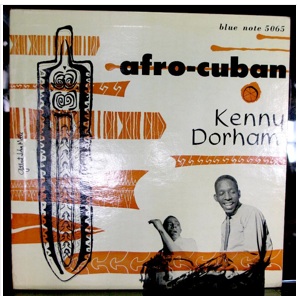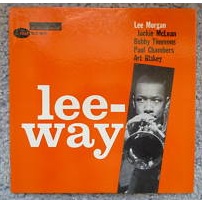Jazz Vinyl on eBay: Blue Notes, Bird, Transition
 Here’s some nice jazz vinyl we missed:
Here’s some nice jazz vinyl we missed:
Lee Morgan, Lee-Way, Blue Note 4034. This was an original West 63rd Street pressing. The record was listed in M- condition and the cover was VG++. The price was $847, which is by far the highest we’ve seen for this record in the Jazz Collector Price Guide.
Kenny Dorham, Afro-Cuban, Blue Note 5065. This was an original 10-inch pressing that looked to be in very nice condition: The record was VG++ and the cover was M-, with a crisp, clear picture. The price was $811.91.
Doug Watkins, Watkins at Large, Transition 10. This was an original pressing that was listed in
M- condition, but it did not have the booklet. Still, the price was $875.
Here’s another Mobley for the $1,000 bin: Hank Mobley, Hank, Blue Note 1560. This was an original pressing that was in M- condition for the record and at least VG++ for the cover. The price was $1,158.
And another Bird for the $1,000 bin: Charlie Parker Volume 4, Dial 207. This was an original 10-inch LP that was listed in VG+ condition for the vinyl — with some background noise in the description — and probably VG+ or VG++ for the cover. The price was $1,009.


The Kenny Dorham is a great record. I have a Japanese pressing, which sounds pretty good…but can’t compare it to the original. Anyone know the differences between the King and Toshiba Blue Note records? I heard King is of superior quality?
what is extra about the “corresponding” 12″ LP BLP 1535, Kenny Dorham – Afro-Cuban, is that the twelf incher has got one side of material not issued elsewhere. In the transition period between 10 and 12″ three long tracks were left unissued until they produced # 1535.
Whereas I am liquidating my 12″ re-issues of ten inch material, e.g. # 1501/2 Miles, 1505/6 J.J., 1526 Cl. Brown, 1537 Lou Donaldson, # 1535 is a must to be kept.
Rudolf — why are you eliminating the 12-inchers? I would have thought, if anything, you would keep those and eliminate the 10-inchers. Not that I should talk after failing to eliminate anything.
I’ve got the Dorham as a reissue(UA,mono,clipped corner)-you know the series. Sounds good to me! My experience with King/Japan is that the pressings are extremely quiet and true to the source material-one that comes to mind especially is an LP with Art Pepper and Ted Brown on Vanguard,FREEWHEELING. Nice! So,for me,King always gets the nod.
Hey, Al, I sent you an email the other day. Did you get it? 😉
Mattyman, The Netherlands.
Al: indeed I am slimming down by selling off 12″ Blue Note albums which are re-issues of material initially issued on 10″. My philosophy is that the ten inchers were produced within one artistic conception, with the tracks in a special order, with their original liners (or not), with original art work etc. They were within one concept. This is very obvious for each of the J.J. Johnson ten inchers on Blue Note. I got to know most of this music initially in 10″ format.
The 12″ re-issues don’t give me the same satisfaction. They are sometimes messy (order of the tracks), sometimes incomplete and, of course, not the originals.
I recently sold Lou Donaldson BLP 1537: this record misses one long track of the sextet session, which is on the 10″. I sold BLP 1526 – Clifford Brown. This record misses 1 or 2 tracks which are on the two underlying ten inchers. The same for the Horace Silver trio sessions (1520?), there are at least two tracks missing which are on the original ten inchers. So why keeping these in my collection when I can make good money for them?
You might reply that the Miles Davis volumes 1 and 2 have extra takes not on 10″. True, but incomplete, all the existing takes were finally issued only on CD. So I kept the three Miles Davis 10 inchers and have the CD.
I think the above reasoning gives a good justification for selling off records which in itself are valuable. How could I otherwise defend the case?
Regarding King and Toshiba.
I have around 30 Japanese Blue Notes – half King and half Toshiba.(Sometimes its all we can get or afford!)
The “hype” about King I think originates from that ambiguous reference to a “Masterpiece Series in the ~rmay authoritative labelography:
http://kleene.ss.uci.edu/~rmay/Bluenote.html
“(iii) Blue Note Masterpiece. I own one of these,…dated March, 1983. ..what I do know is that this is, sonically, probably the best sounding Blue Note I own, including original pressings. No other recording conveys the magic the way this one does”
He goes on to add:
“In general, King’s have better sound than Toshiba’s, which tend to be a bit on the bright side by comparison, although usually not annoyingly so”
This all comes in small section on King Reissues. King produced a number of so-called “Masterpiece” series which are not the “Blue Note Masterpiece Special Replica 15” Series the author is waxing lyrical over.
There are hundreds of Kings in the “Blue Note Masterpiece Selection 150” Series and “Blue Note Masterpiece Vols.1-4” which are not the “Special Replica 15 Series”
If you read the whole section it could be interpreted as applying to all Kings, or all the “Masterpiece” series, due to the author’s incomplete knowledge
http://microgroove.jp/bluenote-jpn/1977-1983.html
No doubt Japanese pressings are “silent vinyl” Of what you can hear is, to my ear, nothing compared to the vitality of Blue Note original pressings. Toshiba I find quite dull and flat in comparison. King slightly better, but neither “breathe” fully.
The other aspect of Kings reputation is that the contemporary US and European reissues of the EMI period – EMI France and Capitol Mahattan are so universally dreadful, the Japanese positively shine in comparison.
I would rate some of my Division of Liberty reissues far superior to even the mighty King.
regarding japanese: I agree with LC that sonnicly the lliberties and kings are about the same, and only originals have that direct heavy sound. But i myself buy japanese BN’s because of the jackets. They often have the original jacket (front and back) The latest batch (alfred lions 100th birthday) have stunning jackets.Deep heavy printing ,orig. numbers)
The reason i sometimes want the liberty pressing is that they sometimes issued them as mono.
United artist pressed a batch with mono AND original jackets.
The differents in sonnics is often only heard if directly compared to each other, wich you normaly never do.
Yes this record is a great one and is very expensive. Kenny Dorham’s music was awesome. He was as great as anyone else but was very underrated.
Thanks folks for your inpout. I have the Toshiba/Emi 10″reissue, while I do think sound is great, I also feel it lack the full richness, and is quiter. Which is fine, I just crank the system and it go. I’m sure someday I’ll get around to finding other copies to compare.